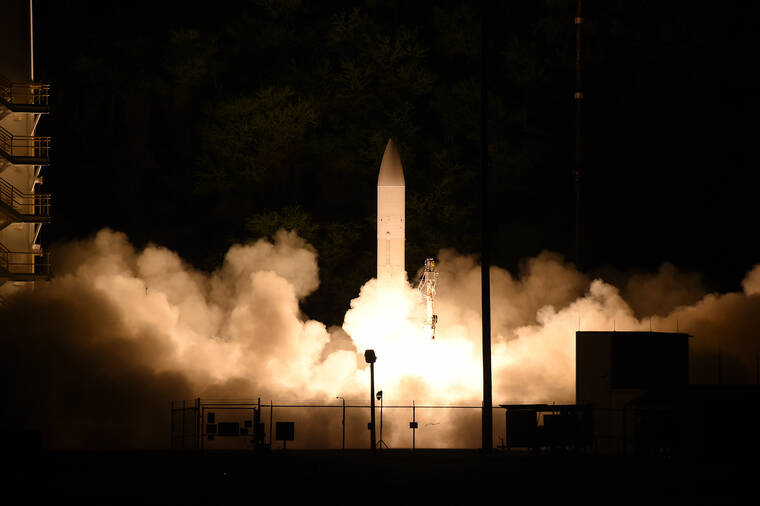Hypersonic missile test fails off Hawaii in fresh setback for program

U.S. NAVY VIA AP
A handout photo provided by the U.S. Navy shows a common hypersonic glide body (C-HGB) launching from the Pacific Missile Range Facility on Kauai on March 19, 2020, during a Department of Defense flight experiment.
A flight test of a hypersonic missile system in Hawaii ended in failure due to a problem that took place after ignition, the Department of Defense said, delivering a fresh blow to a program that has suffered stumbles.
It didn’t provide further details of what took place in today’s test, but said in a statement sent by email “the Department remains confident that it is on track to field offensive and defensive hypersonic capabilities on target dates beginning in the early 2020s.”
“An anomaly occurred following ignition of the test asset,” Pentagon spokesman Navy Lt. Cmdr. Tim Gorman said in the statement.
“Program officials have initiated a review to determine the cause to inform future tests,” he said. “While the Department was unable to collect data on the entirety of the planned flight profile, the information gathered from this event will provide vital insights.”
The trial marked the second unsuccessful test flight of the prototype weapon known as Conventional Prompt Strike. There was a booster failure in its first flight test in October, which prevented the missile from leaving the launch pad. The Conventional Prompt Strike weapon is envisioned to be installed on Zumwalt destroyers and Virginia-class submarines.
The Army is developing a land-based version. Lockheed Martin Corp and Northrop Grumman Corp. are the top contractors.
Don't miss out on what's happening!
Stay in touch with breaking news, as it happens, conveniently in your email inbox. It's FREE!
The Pentagon is feeling pressure to deploy hypersonic systems as rivals including Russia, China and North Korea are pressing ahead with the systems designed to evade interception by flying at more than five times the speed of sound and gliding on a maneuverable path to deliver nuclear warheads.
China is investing heavily in hypersonic weapons, putting one in orbit in July of last year that flew 25,000 miles in more than 100 minutes of flight, according to the top U.S. nuclear commander. In January, North Korea conducted two separate launches of hypersonic missile systems that traveled several hundred kilometers.
Russia debuted a hypersonic air-to-ground missile in its attack on Ukraine. Adversaries don’t have to meet the rigorous standards set under the US defense acquisition system or face public scrutiny over delays and failure.
The slower pace of U.S. hypersonic programs prompted a number of heated exchanges when Defense Secretary Lloyd Austin testified in April before the House Armed Services Committee.
“You recently called in the defense industrial community that were involved in the hypersonics development as to how we can speed that up,” Rep. Mike Turner, R-Ohio, said. “We’re behind our adversaries.”
Without denying that, Austin said “we have to be careful” because “hypersonic is a capability, sir, but it’s not the only capability.” He added “I have engaged industry” to “make sure that they’re leaning into” hypersonic development.



